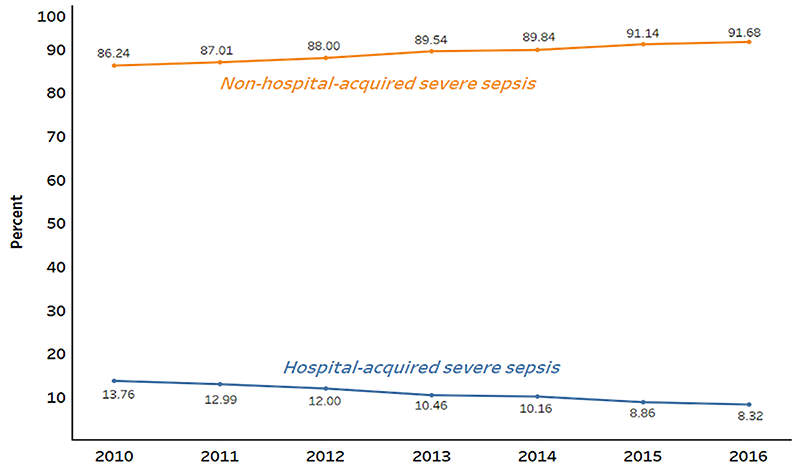Severe Sepsis: 30-Day Mortality

Sepsis is caused by the body’s inflammatory response to uncontrolled infections, and it impacts over 1.5 million people in the United States yearly (CDC basic information sepsis, updated September 2016; CDC Vital Signs 2016). In California alone, sepsis charges totaled $36.8 billion in 2016. Sepsis is a preventable, life threatening medical condition for which the number of cases and deaths has increased over the past several years. If not treated properly, sepsis can result in a severe condition with multiple organ failure (severe sepsis) and death.
This Data Pulse presents information on patients who were alive at discharge and died within 30 days of discharge from 2010 to 2016.
Key Findings
- From 2010 to 2016, the majority of severe sepsis patients who died within 30 days following discharge died at a skilled nursing facility. Although the percent gradually declined over the years, a notable decrease occurred in 2015 with the introduction of Hospice Care as a discharge category.
- In 2016, Hospice Care was the most common discharge category, surpassing skilled nursing facility.
- The percent of hospital-acquired severe sepsis patients who died within 30 days of discharge decreased appreciably while the percent of non-hospital-acquired severe sepsis patients increased slightly.
Figure 1. Place/Location where Severe Sepsis Patients were Discharged or Transferred to Among those who Died within 30 days of Discharge**, 2010-2016

In 2015, “Hospice Care” was added to the HCAI discharge disposition codes; this addition reduced the number of deaths in each of the other six disposition codes. The largest decrease was seen in the skilled nursing category, which decreased 24 percent in 2015 and nearly that amount in 2016. Since the addition of “Hospice Care”, it has been the most common category for patients who died 30 days following discharge (37.6 percent in 2015 and 42.1 percent in 2016) (Figure 1).
Among patients that died within 30-days of discharge, the percent of patients with hospital-acquired severe sepsis decreased by 39.3 percent from 2010 to 2016, while the percent of patients who did not have hospital-acquired severe sepsis increased 6.3 percent (Figure 2).
Figure 2. Percent of Hospital-acquired and Non-hospital-acquired Severe Sepsis Among Patient Deaths within 30 days of Discharge**, 2010-2016

About Sepsis
The following symptoms are signs of sepsis: shivering, fever, or very cold; extreme pain or discomfort, clammy or sweaty skin, confusion or disorientation, shortness of breath, and high heart rate
(CDC: making healthcare safer updated July 2017, CDC Vital Signs 2016).
Although any person can contract sepsis, some people are at an increased risk, including those over the age of 65, persons with chronic medical conditions, and those with weakened immune systems.
(CDC: What is Sepsis?)
Sepsis can be acquired while a patient is hospitalized for another illness or procedure; these are referred to as hospital-acquired cases.
Data and Resources
Data Pulse – Severe Sepsis: In-Hospital Mortality
Additional Information
Topic: Healthcare Utilization
Temporal Coverage: 2010-2016
Spatial/Geographic Coverage: Statewide
Source: Department of Health Care Access and Information: California Patient Discharge Data 2010-2016

